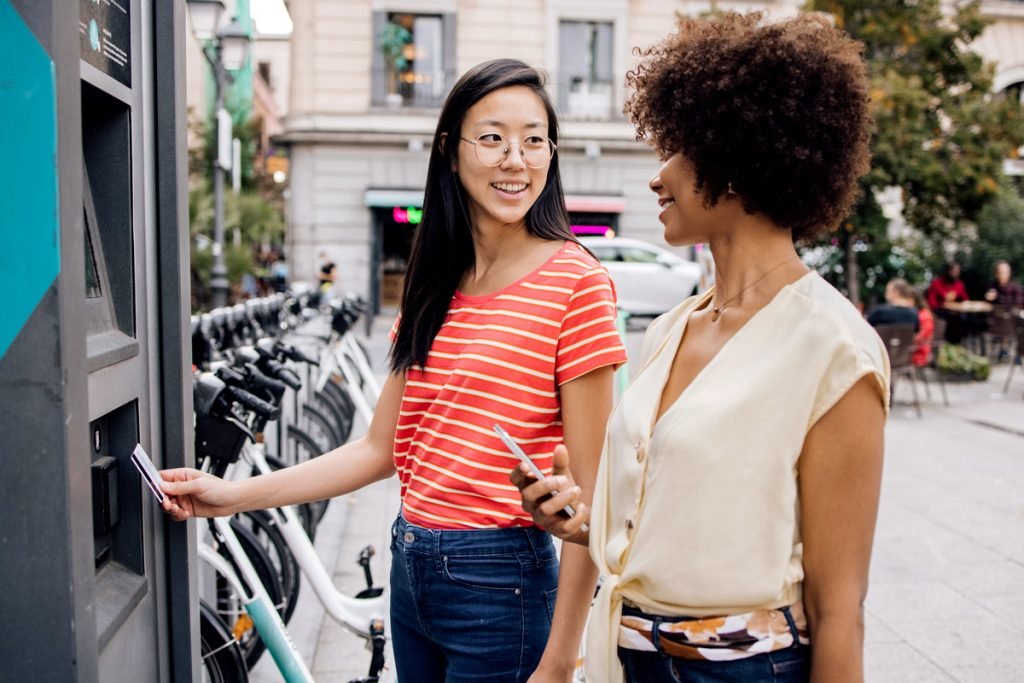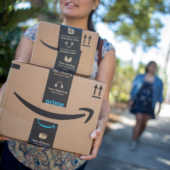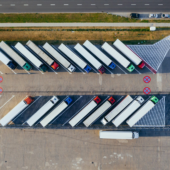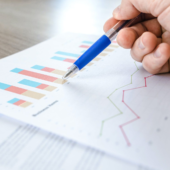by Timothy Moore
Contributor
Using an automated teller machine, or ATM, is a common part of personal finance for most Americans. You can use an ATM to deposit and withdraw cash at your bank or credit union, as well as transfer money between accounts and check on your account balance.
If you’re new to using ATMs or are worried about doing so safely, review our step-by-step guide to deposit and withdraw cash at an ATM.
To use an ATM:
If you don’t have a debit card for your checking account, your bank likely provided you with an ATM card. ATM cards are also common if you have a savings account without an associated checking account or maybe be attached to accounts at credit unions, including money markets.
You can also use a credit card at an ATM, but this qualifies as a “cash advance” and is very expensive. Fees can surpass $8 or 3% of the total transaction. Only use a credit card at an ATM when you have no other option.
If you have a debit card with a chip, make sure you insert the chip end into the ATM.
Some machines require you to leave your card in during the transaction while others may prompt you to remove it before continuing.
You must activate a debit card before you can use it at an ATM. Activate a card via phone or online when you receive it in the mail rather than waiting until you arrive at the ATM.
Newer ATMs allow for cardless transactions. Instead, you can use your smartphone digital wallet (Apple Pay, Google Pay, Samsung Pay, etc.) in place of a card.
Many ATMs will prompt you to select your preferred language. Most machines will offer at least three common languages based on their location. In the US, you can count on English and Spanish to be offered as options.
Never assume an ATM will use English when traveling abroad. While it’s likely you’ll be able to find a machine in English, it’s safer to exchange a small amount of money for local currency before leaving an airport or train station when visiting a new country. This way, you’ll have some cash until you can find a machine that has an English option.
Your PIN, or personal identification number, is how you’ll verify to the machine that you are the true account owner and have the right to access the funds associated with the debit card. When creating a PIN for your checking account, choose a unique combination of four numbers that you don’t use for anything else. Avoid old addresses, the last four digits of your phone number or any part of your Social Security Number.
Do not write this PIN down, and do not share it with anyone who should not have access to your account. Later on in our post, we’ll talk about how to use an ATM safely, which includes protecting your PIN when punching it in.
While depositing and withdrawing cash are the two most common activities you can complete with an ATM, there are other things you can do. For example, ATMs at banks and credit unions typically allow you to deposit checks. You can often use ATMs to transfer funds between bank accounts. If you don’t have a mobile app for your financial institution, an ATM is a good way to get your account balance.
If you are depositing cash, insert the bills as shown. Most ATMs allow you to insert multiple bills at once. Some ATMs may allow you to deposit coins.
If depositing a check, make sure you have signed the back. Insert the check and punch in the amount for which it is written. An actual person will be reviewing this check against what you type in (same with mobile deposits).
If withdrawing cash, enter in the amount you would like to withdraw. Typically, ATMs offer “fast cash” options, allowing you to select a button for $20, $40 or $60 dollars (amounts will vary but are often in increments of $20). You can also manually input how much cash you would like to withdraw, but remember, various banks and credit unions have firm daily limits. Familiarize yourself with the limit implemented by your own financial institution before attempting to withdraw money.
If simply checking your bank account balance, click that option. The balance is typically printed on a receipt, though some ATMs may also display it on the screen.
If the ATM has an option to transfer money from one bank account to another (within the same bank), you can also select that option.
Never walk or drive away from an ATM until you have received all withdrawn funds, a receipt and your debit card. Look for a thank-you screen prompt from the ATM to make sure the session is over.
Always make sure you have your card when you leave an ATM.
There are inherent risks to using an ATM, and they extend beyond a physical person lurking behind you trying to steal the cash you receive. Follow these safety tips when using an ATM:
Sometimes your only option at 3 a.m. is an ATM at a gas station in the middle of nowhere, but in general, it is better to transact at ATMs at a physical bank branch.
Before pulling out your wallet at an ATM, check to make sure no one seems to be watching you or hovering too close. Thieves, especially in darker locations at night, can use this opportunity to snatch a wallet or purse before you even begin.
Even worse, some may strike the moment you withdraw money and have cash in hand. If you are ever unsure of your surroundings, do not use the ATM. Instead, find another ATM where you feel safer.
Don’t keep your PIN stored in your phone, on a slip of paper or in a document on your computer. Instead, select a unique PIN when setting up your debit or ATM card and commit it to memory.
Do not share this with friends and family unless there is a clear reason to do so (spouse and children may need to know the PIN).
When entering your PIN at an ATM, cover the PIN pad with your other hand to prevent watchful eyes or even cameras from picking up on which numbers you select.
Be wary of debit card skimmers. Criminals can install these on ATMs (gas station pumps are also common targets) to collect your card number and PIN.
To detect an ATM skimmer where you normally insert your card, look for obvious signs of tampering. This could include glue residue or tape, bulky hardware on the card reader or anything “loose” dangling from the card reader. Before inserting your card, try to wiggle the card slot. If it is loose and can shift in place, it is possible someone has attached a skimmer.
Because criminals can also attach small cameras, always shield button presses on the PIN pad with your other hand. You can try to scout out hidden cameras before transacting. Look for small pin holes drilled into the ATM; these often conceal tiny cameras.
Finally, if the keypad itself seems to have large keys or is unusually thick, it is possible a criminal has installed a fake pad over a real keypad.
If you are ever unsure, do not continue with the transaction. However, don’t just leave the ATM for the next unsuspecting customer. Report it to the bank immediately and if it is at a grocery store, casino or gas station, report it to the business owner, but also call the customer service line for the maker of the particular ATM, if possible.
Depending on where you bank, you have access to a range of ATMs domestically and internationally. A larger national bank will have its own network of ATMs while smaller banks — especially newer online banks — typically belong to an interbank network of ATMs.
Your bank’s mobile app should have an ATM locator that helps you find nearby in-network ATMs. In-network ATMs mean you don’t have to worry about ATM fees. If you deposit or withdraw funds at an out-of-network ATM, you may be subject to fees, so it’s a good idea to find a bank within your network.
No luck in the mobile app? Check the back of your debit or ATM card for an indication of your bank’s particular network. Then google to find ATM locations within your network.
ATM fees averaged more than $3 in 2021. To avoid paying an ATM fee, find an ATM within your bank’s network—and consider switching to a bank account that helps you avoid ATM fees.
Some of the best bank accounts for ATM fees offer universal ATM surcharge reimbursement, meaning you can use an ATM anywhere in the world, and your bank will cover any fees you incur. Other banks offer this but only at a domestic level. Still other financial institutions offer ATM fee reimbursements up to a certain amount, like $20/month; others may not offer reimbursement but still try to attract customers with large ATM networks.
You can also avoid ATM fees by choosing the cash back option at the grocery or going into a physical bank branch to withdraw or deposit money.
Automated teller machines aren’t your only option for withdrawing money. Here are some alternatives to ATM cash withdrawals:
Many grocery stores offer cash back when you use your debit card. Rather than incur an ATM fee of $3, spend a fraction of that on something small that you need, then opt for cash back at checkout.
If depositing a check, no need to go to a physical branch or ATM. Most banks now offer mobile check deposit as part of their suite of personal finance options.
You can get your cash withdrawal the old fashioned way: Go to a bank teller, present your account information and ask them for your money.
If you find that you regularly go to an ATM to withdraw money, take out more than usual next time—but only if you won’t be tempted to spend it all immediately. Doing so can reduce your visits to ATMs, saving you time and helping you avoid the potential dangers of more frequent trips to the ATM.
If an establishment accepts credit or debit card purchases, opt for using plastic instead of cash. (Cash is pretty dirty, after all.)
If you have set up a digital wallet in your smartphone, patronize establishments that accept this payment.
And for peer-to-peer payments (e.g., paying a friend back for getting you dinner or giving your niece money for her birthday), opt for money transfer apps like Venmo or Cash App.
Still have questions regarding how to use an ATM? We’ve collected some of the most common questions our readers have been asking about ATMs and provided answers.
Timothy Moore covers banking and investing for The Penny Hoarder from his home base in Cincinnati. He has worked in editing and graphic design for a marketing agency, a global research firm and a major print publication. He covers a variety of other topics, including insurance, taxes, retirement and budgeting and has worked in the field since 2012.
Ready to stop worrying about money?
Get the Penny Hoarder Daily
Privacy Policy
© 2022 The Penny Hoarder. – All rights reserved.
Privacy Policy and Terms of Service | Do Not Sell My Personal Information | Cookies Settings






